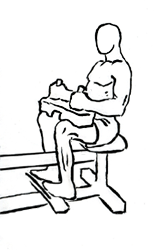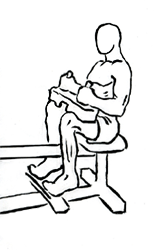Last Updated on September 25, 2014
The Seated Calf Raise using Machine is for anyone aiming to achieve strong, well-defined legs, calf exercises are non-negotiable. While often overlooked in favor of quad or glute exercises, the calves play a crucial role in stability, power, and athleticism. The seated calf raise is one of the simplest yet most effective ways to build calf strength and shape, specifically targeting the soleus muscle—a deeper muscle often undertrained with other calf exercises. This targeted approach makes seated calf raises a must-have exercise for anyone looking to improve both the appearance and functional power of their lower legs.
Section 1: Understanding the Seated Calf Raise using Machine and Muscle Anatomy
Anatomy of the Calves
The calves are composed of two main muscles:
- Gastrocnemius: The visible “bulky” calf muscle primarily engaged in standing calf exercises.
- Soleus: A deeper muscle activated more in bent-knee exercises, like the seated calf raise.
The seated calf raise effectively isolates the soleus muscle, offering benefits that other calf exercises simply can’t match. Strengthening the soleus muscle contributes to endurance, balance, and a more stable foundation for exercises like squats, lunges, and even running.
Section 2: Step-by-Step Guide to Mastering the Seated Calf Raise using Machine
Setting Up on the Machine
- Position Yourself
- Start by sitting at the calf raise machine with your legs positioned comfortably. Make sure you’re sitting upright and that the seat height allows you to place your feet securely on the footpad.
- Feet Placement
- Place the balls of your feet on the edge of the footpad, letting your heels hang off to maximize the range of motion. This setup ensures that your calves will work through both the eccentric and concentric phases.
- Adjust the Thigh Pad
- Position the leg pad just above your knees. This pad keeps your legs stable, preventing movement as you raise and lower the weights.
Executing the Movement
- Unlock the Bar
- Depending on the machine, you may need to lift and release a lever or safety bar to start the movement. Ensure the bar is unlocked so you can perform the exercise with a full range of motion.
- Lift and Squeeze
- Begin by pushing through the balls of your feet to lift your heels as high as possible. Focus on a slow, controlled lift, and squeeze your calf muscles at the top of the movement. This squeeze helps maximize muscle contraction.
- Controlled Descent
- Slowly lower your heels back to the starting position, allowing your calves to stretch slightly below the footpad. Resist the urge to “drop” your heels quickly; a controlled descent is key to muscle growth.
- Repeat for Reps
- Perform 10-15 reps per set, focusing on smooth, steady movement rather than speed.
Section 3: Benefits of the Seated Calf Raise using Machine
- Targeted Muscle Activation
- Unlike standing calf raises, the seated calf raise specifically targets the soleus muscle. This muscle is essential for endurance and stability in the calves, which supports various activities, from walking and running to weightlifting.
- Improved Athletic Performance
- Strong calves play a major role in sports that require jumping, sprinting, or sudden directional changes. A strong soleus improves ankle stability, reducing the risk of injuries.
- Increased Aesthetic Appeal
- Building both the soleus and gastrocnemius muscles creates a balanced, more developed calf muscle, enhancing the appearance of the lower legs.
- Support for Functional Fitness
- Strengthening the soleus muscle contributes to better mobility and endurance in everyday activities, such as walking or climbing stairs.
Section 4: Common Mistakes to Avoid
- Using Too Much Weight
- Mistake: Many lifters assume heavier weights mean better gains. However, excessive weight often leads to form breakdown and less muscle engagement.
- Solution: Focus on form and control over weight. Choose a manageable weight that allows you to perform each rep correctly.
- Bouncing Instead of Controlled Movement
- Mistake: Rapid, uncontrolled reps use momentum rather than muscle power, reducing the exercise’s effectiveness.
- Solution: Slow down, focusing on a controlled lift and lower for each rep.
- Not Fully Extending and Contracting
- Mistake: Stopping short of a full stretch or contraction limits muscle engagement.
- Solution: Make sure to lift your heels as high as possible and lower them below the footpad to ensure a full range of motion.
- Poor Foot Positioning
- Mistake: Positioning feet too far forward or backward on the footpad can compromise balance and muscle engagement.
- Solution: Keep the balls of your feet on the edge of the footpad for maximum range of motion.
Section 5: Pro Tips for Perfecting Your Technique
- Focus on the Squeeze
- At the top of the movement, hold for an extra second and squeeze your calf muscles hard. This added tension increases muscle fiber recruitment, promoting better gains.
- Experiment with Rep Ranges
- Try different rep ranges for various results. Higher reps (15-20) at lighter weights build endurance, while lower reps (8-10) at heavier weights focus on strength.
- Use Slow Negatives
- During the lowering phase, take 2-3 seconds to fully lower your heels. This method, known as “eccentric training,” helps improve strength and muscle growth.
- Add Tempo Training
- For an extra challenge, incorporate tempo changes (e.g., two counts up, four counts down) to maximize time under tension.
Section 6: Variations to Keep Your Routine Fresh
- Single-Leg Seated Calf Raise
- Perform the seated calf raise one leg at a time to improve symmetry and isolate each calf individually.
- Toes-In/Toes-Out Calf Raise
- By adjusting your toe position, you can target different parts of the calf. Pointing toes inward works the outer calf, while pointing them outward emphasizes the inner calf.
- Standing Calf Raise for Gastrocnemius Activation
- Balance your calf training by adding standing calf raises, which focus more on the gastrocnemius, the outer muscle of the calf.
- Smith Machine Seated Calf Raise
- If a seated calf machine isn’t available, use a Smith machine and a block for a similar movement. Place the bar over your knees, and lift and lower your heels.
- Explosive Reps for Power Development
- Perform seated calf raises with slightly more speed on the way up for a power-focused approach, but maintain control on the way down.
Section 7: Integrating Seated Calf Raise using Machine into Your Routine
For best results, integrate seated calf raises into your lower body or leg day routine. Here’s how to fit it into different levels of training:
- Beginners: 3 sets of 10-15 reps, focusing on form.
- Intermediate: 4 sets of 12-15 reps, experimenting with slow negatives and higher weight.
- Advanced: 5 sets of 8-10 reps, incorporating variations like single-leg or tempo reps.
Training calves 2-3 times per week ensures ample growth and endurance improvements without overtraining.
Section 8: How to Track Your Progress for Maximum Gains
Tracking your workouts helps identify areas for improvement. Keep a log of:
- Weight Used: Note any weight increases over time.
- Reps and Sets: Record how many reps and sets you perform each session.
- Time Under Tension: Tracking how long you spend on each rep can help you increase control and growth.
Signs of Progress:
- You can lift heavier weights with control.
- Calves appear more defined.
- Enhanced stability during other leg exercises or activities like running.
Section 9: The Importance of Calf Stretching and Mobility Work
Stretching
After calf exercises, stretching can improve flexibility, reduce soreness, and support muscle recovery. Try a wall calf stretch or downward dog yoga pose to target the entire calf area.
Foam Rolling
Using a foam roller to roll out your calves after a workout can relieve tightness and improve blood flow to the muscle, supporting quicker recovery.
Ankle Mobility
Good ankle mobility supports full-range calf raises and reduces the risk of injury in other exercises, like squats and lunges.
Section 10: Frequently Asked Questions (FAQs)
1. How often should I do seated calf raises?
For most people, training calves 2–3 times per week provides good results without overtraining.
2. Is it better to do high reps or low reps for calves?
Both high reps and low reps have benefits. High reps improve endurance, while low reps build strength and size.
3. Can seated calf raises improve athletic performance?
Yes! Strong calves provide a stable foundation for movements in running, jumping, and other athletic activities.
4. Should I stretch my calves after a workout?
Yes, stretching post-workout helps maintain flexibility and aids recovery.
Conclusion
The seated calf raise using machine is an essential exercise for anyone looking to build strong, defined calves. By targeting the soleus muscle, it adds depth to your calf training that other exercises may miss. Whether you’re an athlete seeking explosive power or a fitness enthusiast aiming for aesthetic balance, seated calf raises are a key component of any effective leg workout.
With proper form, controlled movements, and a focus on technique, you can make the most out of this seemingly simple exercise. Remember to vary your routine, track your progress, and incorporate recovery strategies for optimal gains. Stick with it, and watch your calves transform into stronger, more defined muscles ready to support your fitness goals.


Exercise images by Everkinetic.






